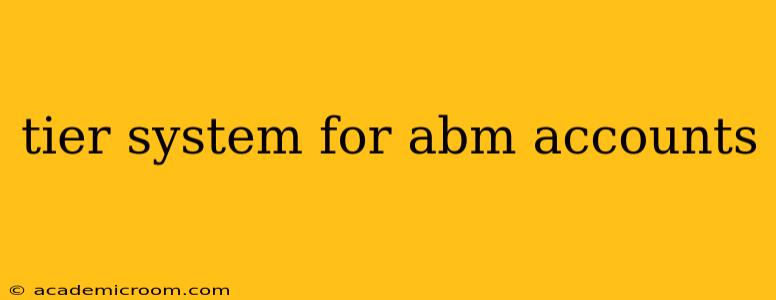Account-Based Marketing (ABM) is a highly targeted strategy focused on engaging a select group of key accounts. To maximize efficiency and ROI, many organizations find it beneficial to create a tiered system for classifying these accounts. This allows for the strategic allocation of resources based on each account's potential value and engagement level. This post will explore how to build a robust tiered ABM system.
What is a Tiered ABM System?
A tiered ABM system categorizes your target accounts into different tiers, each representing a varying level of strategic importance and resource allocation. This isn't just about revenue potential; it considers factors like competitive landscape, strategic fit, and long-term value. The system allows for a more personalized and efficient approach, ensuring that your highest-value accounts receive the most attention and resources.
How to Define Your ABM Tiers
Defining your tiers requires a clear understanding of your ideal customer profile (ICP) and your overall business objectives. Typically, a three-tier system is a good starting point, but you can adjust this based on your specific needs.
Tier 1: Strategic Accounts (High-Value, High-Touch)
These are your most important accounts. They represent significant revenue potential, strong strategic alignment with your business goals, and potentially a high influence on your market. These accounts receive the highest level of personalized attention, with dedicated teams and significant resource investment.
- Characteristics: High revenue potential, strong brand alignment, significant market influence, complex sales cycles.
- Resource Allocation: Dedicated account teams, personalized campaigns, high-touch engagement (executive briefings, customized content, VIP events).
- Example: A Fortune 500 company in your industry with a substantial need for your product or service.
Tier 2: Key Accounts (Medium-Value, Medium-Touch)
These accounts represent a substantial revenue opportunity and a good strategic fit, but may require less intensive engagement than Tier 1 accounts. While still requiring significant attention, resources are managed more efficiently.
- Characteristics: Moderate revenue potential, good brand alignment, potential for expansion, moderate sales cycle complexity.
- Resource Allocation: Dedicated account managers, targeted campaigns, multi-channel engagement (email, social media, webinars).
- Example: A mid-sized company with a strong track record of growth and a clear need for your solution.
Tier 3: Emerging Accounts (Low-Value, Low-Touch)
These accounts hold future potential but currently demand less resource commitment. Focus here is on nurturing relationships and building brand awareness, preparing them for potential upward movement in the tiered system.
- Characteristics: Lower revenue potential, potential for future growth, less immediate need for your solution, shorter sales cycle.
- Resource Allocation: Automated marketing campaigns, general content marketing, less personalized interaction.
- Example: Smaller companies with emerging needs in your industry that might become Tier 2 accounts in the future.
Factors to Consider When Tiering Your Accounts
Beyond revenue potential, several crucial factors influence account tiering:
- Account Size and Revenue: Revenue generated or potential revenue is a primary driver.
- Strategic Alignment: How well does the account fit with your overall business strategy?
- Customer Lifetime Value (CLTV): What's the projected long-term value of the relationship?
- Competitive Landscape: Are there strong competitors vying for this account?
- Decision-Maker Influence: Who are the key decision-makers and what's their influence within the industry?
- Relationship Strength: What's the existing relationship like?
Frequently Asked Questions
How often should I review and adjust my ABM tiers?
Regularly reviewing your ABM tiers—ideally quarterly or annually—is crucial to ensure they remain relevant. Market changes, account performance, and evolving business goals all necessitate adjustments.
What metrics should I use to measure the success of my tiered ABM system?
Track key metrics like revenue generated per tier, sales cycle length, conversion rates, and customer lifetime value (CLTV) for each tier. This data will inform future resource allocation and system refinements.
Can I use a different number of tiers?
Absolutely. A three-tier system is common, but you could have two, four, or even more, depending on your organization's size and complexity. The key is to create a system that's practical and manageable for your team.
How do I avoid alienating accounts in lower tiers?
Transparency and communication are key. Even though lower-tier accounts receive less individualized attention, they should still receive valuable content and engagement opportunities that maintain relationships and nurture potential for future growth.
By carefully considering these factors and regularly reviewing your system, you can create a tiered ABM system that maximizes your ROI and helps your business achieve its goals. Remember that a successful tiered system is a dynamic one that adapts to changing market conditions and internal priorities.
